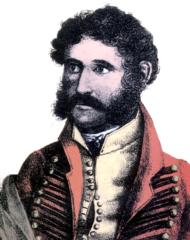La Rioja Province, Argentina
The Diaguita, Capayan and the Olongasta peoples inhabited the territory of present-day La Rioja Province at the time of encounter with the Spanish colonists in the 16th century.In 1783, after the creation of the Viceroyalty of the Río de la Plata, the control of the province of 10,000 inhabitants passed to the Córdoba independency.Following attempts by Bernardino Rivadavia, the first elected President of Argentina, to impose a centralist constitution, the caudillo Juan Facundo Quiroga emerged as a popular leader.Located in the Argentine Northwest area, its landscape is arid to semi-arid, and the dry climate receives annually 200 mm of precipitation, has short winters, and very hot summers.From the Andes at the west, with peaks of up to 6,795 meters (Monte Pissis), the relief's height descends towards the sierras of the neighbouring dry Pampas zone.La Rioja's agriculture (as well as cities) lies on the banks of the few permanent rivers and oases that allow irrigation, with only 190 square kilometres of cultivated land.Since 2024 it has its own currency,[5] the chacho, which was introduced in response to the economic problems caused by President Javier Milei's austerity program and accompanying cuts to federal budget transfers.



ProvinceSpanishTalampaya National ParkArgentinaLa RiojadepartmentsGovernorRicardo QuintelaLegislatureNational DeputiesNational SenatorsFlorencia LópezDemonymTime zoneUTC−3ISO 3166 codeprovince of ArgentinaCatamarcaCórdobaSan LuisSan JuanRiojasaurusFacundo QuirogaPetroglyphsDiaguitaCapayanSpanish colonistsTucumánViceroyalty of PeruCalchaquíViceroyalty of the Río de la PlataBernardino RivadaviacaudilloJuan Facundo QuirogaCarlos Saúl MenemSyrianLebaneseOttoman EmpireCarlos MenemdictatorshipClimate of ArgentinaClimatic regions of ArgentinaArgentine NorthwestMonte PissisPampasChilecitoSierra de VelascoSierra de FamatinairrigationVineyardsuraniumJavier MileiLegislature of La RiojaGovernor of La Rioja ProvinceArgentine Federal PoliceAraucoAimogastaCastro BarrosAmingaChamicalCoronel Felipe VarelaVilla UniónFamatinaGeneral Ángel Vicente PeñalozaGeneral BelgranoGeneral Juan Facundo QuirogaGeneral LamadridVilla CastelliGeneral OcampoMilagroGeneral San MartínUlapesIndependenciaPatquíaRosario Vera PeñalozaChepesSan Blas de los SaucesSanagastaVinchina1894 San Juan earthquakeAmuschinasAndolucasÁngulosAnjullónBanda FloridaChaupihuasiColonia AnguinánColonia CatinzacoColonia MalligastaColonia Ortiz de OcampoColonia VichigastaCuipánDesiderio TelloGuanchínLas TalasLos PalaciosLos SarmientosMirandaPortezueloSan NicolásSan PedroSanta ClaraSanta Vera CruzSanto DomingoTilimuquiUnited Nations Development ProgrammeCapitalSan BlasProvinces of ArgentinaProvincesBuenos AiresChubutCorrientesEntre RíosFormosaLa PampaMendozaMisionesNeuquénRío NegroSanta CruzSanta FeSantiago del EsteroTierra del FuegoAutonomous cityBuenos Aires City